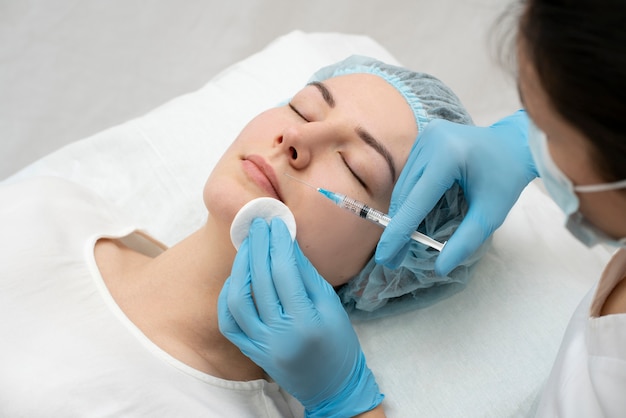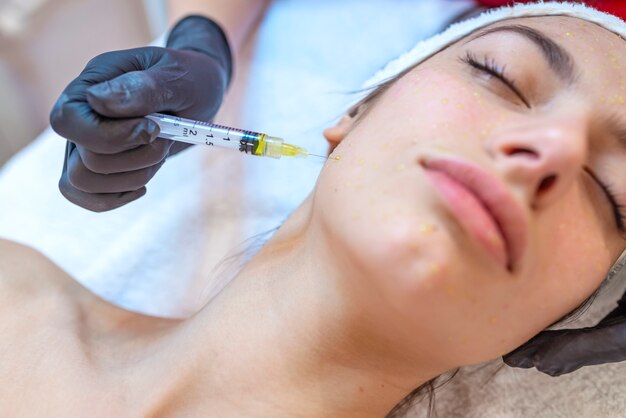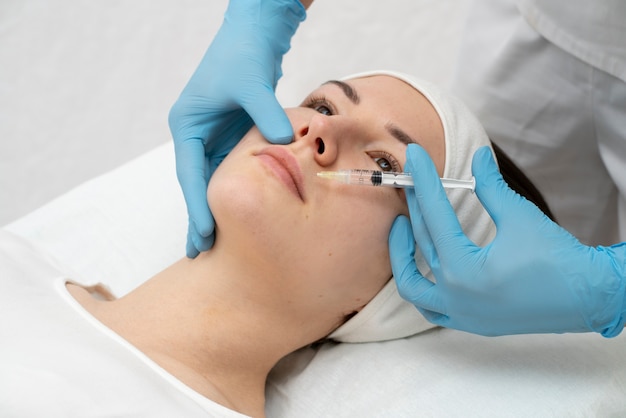Introduction
Aging is inevitable. We all get older, and as much as we try to defy it, the signs start to show. Fine lines, wrinkles, and sagging skin are just part of the package. That said, how we approach these changes is something we do have control over. Whether it’s Botox, dermal fillers, or PRP (Platelet-Rich Plasma), there’s no shortage of treatments designed to turn back the clock. But how does PRP stack up against the more traditional methods? PRP Treatment for Face in Islamabad, Pakistan dives into the benefits of this natural, rejuvenating treatment.
What Are Traditional Anti-Aging Treatments?
Before diving into PRP, let’s discuss the tried-and-true treatments that most people are familiar with. Botox and dermal fillers have been around for a while, and they continue to be popular for a reason.
Botox and Dermal Fillers
Botox is basically the go-to for smoothing out wrinkles. It works by temporarily paralyzing the muscles that cause those fine lines. Think of it as giving your face a quick vacation. Fillers, on the other hand, are designed to restore volume, typically in areas that lose it over time, like the cheeks or under the eyes. These treatments are instant fixes, but let’s be honest: they don’t last forever. Most people need touch-ups every few months, which can add up. How PRP Treatment for Face Restores Youthful Skin Naturally offers a natural, long-term alternative to rejuvenate your skin.

Chemical Peels
Chemical peels can work wonders for those with uneven skin tone, age spots, or acne scars. The process involves applying a solution that removes the outer layer of skin, revealing the fresh, new skin underneath. However, like the others, it’s not a one-and-done treatment. You’ll need to schedule regular sessions to keep the glow going. PRP Treatment for Face Benefits: Is It Worth It? explores a natural alternative that enhances skin health from within.
What Is PRP for the Face?
Now, let’s talk about PRP. If you’re not familiar with it, PRP uses your blood to help rejuvenate your skin. Sounds a little crazy, right? But stick with me—it’s actually a pretty cool treatment. Here’s how it works: a small amount of your blood is drawn, and then it’s spun in a machine (a centrifuge) that separates the platelets from the rest of your blood. Those platelets are then injected back into your face to help stimulate collagen production and skin regeneration.
It might take a little longer to see results with PRP compared to Botox or fillers, but when it kicks in, the effects can last much longer. Plus, it’s natural, as it uses your body’s healing mechanisms.
PRP vs Botox and Fillers
Now that we know what PRP is all about let’s compare it to Botox and dermal fillers. The main question here is: Which one gives you the most bang for your buck?
Immediate Results vs. Long-Term Benefits
Botox and dermal fillers are known for providing instant results. Botox can smooth out lines within a few days, and dermal fillers provide immediate volume restoration. It’s the quick fix for those who want to look refreshed pronto. But here’s the catch: you’re going to need regular touch-ups. Botox usually wears off after three to six months, and fillers can last anywhere from six to twelve months.
PRP is different. It takes a few weeks to notice any changes, but once it starts working, the results continue to improve over time. And unlike Botox or fillers, PRP doesn’t require frequent maintenance. It’s the kind of thing that keeps working in the background long after the treatment.
Safety: Which Is Safer?
This is where PRP gets a big bonus point. Since it’s made from your blood, there’s minimal risk involved. You won’t have to worry about allergic reactions or your body rejecting anything. Some people might experience mild redness or swelling at the injection sites, but these side effects typically fade quickly.
Botox and fillers are generally safe, too. Still, because they involve injecting foreign substances into your skin, there’s a slightly higher chance of side effects—things like swelling, bruising, or even allergic reactions (though these are rare).

How Long Do Results Last?
Here’s the breakdown:
- PRP: Once you start seeing results, they can last anywhere from 6 months to over a year, depending on how your body responds to the treatment. The best part? You don’t have to keep coming back every few months for touch-ups.
- Botox and Fillers: Botox typically lasts 3 to 6 months, and dermal fillers last around 6 to 12 months. So, if you want to maintain those results, expect to go back for more treatments regularly.
If you’re not a fan of constant touch-ups, PRP is your best bet for long-lasting results.
Why PRP for the Face Is Worth Considering
It’s Natural
Let’s be honest: the idea of injecting foreign substances into your skin doesn’t sit well with everyone. If you prefer to keep things natural, PRP is an appealing option. Since it uses your blood, there’s no risk of an allergic reaction, and it’s a much more organic way to enhance your skin’s appearance.
Minimal Downtime
No one likes the idea of downtime after a treatment. PRP is lowkey in this regard. You might have some redness or swelling, but it’s usually gone within a couple of days. Botox and dermal fillers can involve more swelling or bruising that might take a little longer to subside.
Long-Term Skin Health
The thing about PRP is that it’s not just about smoothing out wrinkles or plumping up your face. It helps to rebuild your skin from the inside out. By boosting collagen production, PRP encourages your skin to become healthier and more resilient. Botox and fillers, while effective in the short term, don’t address the long-term health of your skin. PRP does.

What Happens During the PRP Procedure?
Curious about what to expect during a PRP treatment? Here’s the breakdown:
Blood Draw
Don’t worry—this part is quick and straightforward. A small amount of blood is drawn from your arm, just like any routine blood test.
Platelet Separation
Next, your blood goes into a machine called a centrifuge. This spins the blood to separate the platelets from the rest of the blood. This part takes around 10 minutes, and it’s a lot less dramatic than it sounds.
Injection into the Skin
Once the platelets are ready, they’re injected back into your skin. Don’t worry; the doctor will apply a numbing cream before the injections so they’re not painful. You might feel a little discomfort, but it’s generally well tolerated.
Aftercare: PRP vs. Traditional Anti-Aging Treatments
PRP Aftercare
After PRP, you might notice some redness or swelling, but nothing that will keep you from getting on with your life. This usually fades in a day or two, and you can go back to your regular activities. That said, it’s best to avoid strenuous exercise for a day or two to give your skin time to settle.
Botox and dermal fillers also require some aftercare. To minimize bruising or swelling, you might need to avoid certain activities or stay away from hot environments for a few hours.
Why Choose Dr. Taskeen Iqbal for PRP in Islamabad?
If you’re considering PRP in Islamabad, you’ll want to go to someone who knows exactly what they’re doing. Dr. Taskeen Iqbal is an expert in PRP treatments and provides top-notch care for her patients. She uses the latest technology to ensure your treatment is as effective as possible.

State-of-the-Art Technology
Dr. Iqbal’s clinic is equipped with cutting-edge technology, which ensures the best results for your PRP treatment. From the centrifuge to the injections, every step is done with precision and care.
Cost: PRP vs. Botox and Fillers
PRP seems more expensive up front, but if you factor in the fact that the results last longer, it saves you money in the long run. Botox and dermal fillers require repeat visits, and over time, the costs can add up. With PRP, you might only need a few treatments a year, making it a cost-effective solution for long-term skin health.
Conclusion
So, which is better—PRP or traditional anti-aging treatments? It really depends on what you’re looking for. If you want fast results and don’t mind regular touch-ups, Botox or dermal fillers could be the right choice for you. But if you’re after a more natural, long-lasting option that improves your skin’s overall health, PRP might be the way to go.
In Islamabad, Dr. Taskeen Iqbal offers expert PRP treatments that deliver accurate results. If you’re ready to take the next step in your skincare journey, book a consultation today.
FAQs
What is better than PRP for the face?
While PRP is a highly effective treatment, alternatives like dermal fillers or Botox may offer faster results for smoothing wrinkles and adding volume. Each treatment has its benefits, depending on your goals. Dr. Taskeen Iqbal provides personalized consultations to determine which option is best for your skin.
Is PRP good for ageing skin?
Yes, PRP is excellent for ageing skin as it stimulates collagen production, improving skin texture, tone, and elasticity. It’s a natural way to rejuvenate your face without invasive procedures. Dr. Taskeen Iqbal can guide you through the process for optimal results.
What is the success rate of PRP for the face?
PRP for the face has a high success rate, with many patients seeing noticeable improvements in skin quality after a few sessions. The results can vary based on individual skin conditions. Dr. Taskeen Iqbal has a proven track record of successful PRP treatments, ensuring you get the best care.
Which age is best for PRP?
PRP is most effective for people between 30 to 60 years old, as it helps to address early signs of ageing and maintain healthy skin. However, individuals outside this range can still benefit from it. Dr. Taskeen Iqbal tailors PRP treatments to suit patients of all ages for optimal skin rejuvenation.
What is more advanced than PRP?
More advanced treatments include microneedling with PRP, lasers, and stem cell therapy, which combine advanced technology with natural rejuvenation. Dr. Taskeen Iqbal stays up-to-date with the latest skincare advancements to offer the most effective treatments available.

